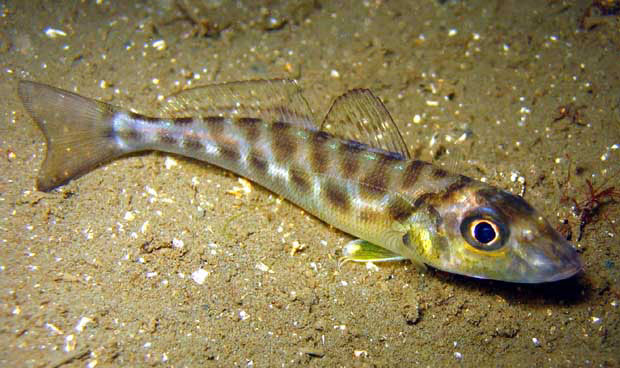Trumpeter Whiting, Sillago maculata Quoy & Gaimard 1824
Other Names: Diver Whiting, Eastern Winter Whiting, Spotted Whiting, Trumpeter Sillago, Western Winter Whiting, Winter Whiting

A juvenile Trumpeter Whiting, Sillago maculata, in the Swan River, Western Australia. Source: Mark Maddern / FishBase. License: All rights reserved
Summary:
A sandy-brown to olive-green or grey whiting becoming above silvery-brown to whitish below, with a dark blotch on the gill cover in some individuals, irregular dark brown blotches on the side, and a golden-silvery mid-lateral stripe. The species has a whitish first dorsal fin with olive-green and brown mottling, and about five rows of brownish-green spots on the soft dorsal fin. The anal and pelvic fins are yellowish with a pale margins, the pectoral fins are yellow to pale yellowish-green with a distinct blackish-blue spot on the fin base, and the caudal fin is olive-brown to a darker greenish-brown with a darker margin.
Cite this page as:
Bray, D.J. 2021, Sillago maculata in Fishes of Australia, accessed 27 Jun 2025, https://fishesofaustralia.net.au/Home/species/3696
Trumpeter Whiting, Sillago maculata Quoy & Gaimard 1824
More Info
|
Distribution |
Great Barrier Reef, Queensland, to Narooma, New South Wales. Inhabits sandy, silty and muddy areas in bays, coastal lakes, river mouths, estuaries, and mangrove-lined creeks. Juveniles are common in sandy and seagrass areas in estuaries and shallow bays during summer, before moving to deeper waters as they mature. |
|
Features |
Dorsal fin XI-XII + I,19-21; Anal fin II, 19-20; Lateral line 71-75; Vertebrae 34-36. Anterolateral extensions of swim bladder recurved posteriorly to reach level of anus. |
|
Colour |
Sandy-brown to olive-green above; sides and lower body silvery-brown to creamy-white; head dark olive-brown to greenish above; cheeks and opercles golden-green, with a dark blotch on the opercle in some individuals; sides with characteristic dark brown irregular blotches and a golden-silver mid-lateral stripe. Spinous dorsal fin whitish, with olive-green and brown mottling; soft dorsal-fin with about five rows of brownish-green spots. Anal and pelvic fins golden to yellow with pale margins; pectoral fins are yellow to pale yellowish-green, with a distinct blackish-blue spot on the base; Caudal fin olive-brown to darker green-brown with darker margins. |
|
Feeding |
Juveniles feed mostly on small crustaceans, while adults mostly consume polychaete worms and bivalve molluscs. |
|
Fisheries |
A highly regarded table fish, taken by recreational and commercial fishers. |
|
Species Citation |
Sillago maculata Quoy & Gaimard 1824, Voyage autour du Monde 1: 261, pl. 53(2). Type locality: Sydney, New South Wales. |
|
Author |
Bray, D.J. 2021 |
|
Resources |
Trumpeter Whiting, Sillago maculata Quoy & Gaimard 1824
References
Alleyne, H.G. & Macleay, W.J. 1877. The ichthyology of the Chevert Expedition. Proceedings of the Linnean Society of New South Wales 1(3–4): 261-281, 321-359, pls 3-9, 10-17 (described as Sillago gracilis)
Burchmore, J.J., Pollard, D.A., Middleton, M.J., Bell, J.D. & Pease, B.C. 1988. Biology of Four Species of Whiting (Pisces : Sillaginidae) in Botany Bay, New South Wales. Australian Journal of Marine and Freshwater Research 39(6): 709–727. https://doi.org/10.1071/MF9880709
Coleman, N. 1980. Australian Sea Fishes South of 30ºS. Lane Cove, NSW : Doubleday Australia Pty Ltd 309 pp.
Coull, B.C., Greenwood, J.C., Fielder, D.R. & Coull, B.A. 1995. Subtropical Australian juvenile fish eat meiofauna: experiments with winter whiting Sillago maculata and observations on other species. Marine Ecology Progress Series 125: 13–19. https://doi.org/10.3354/meps125013
Edgar, G.J. 2008. Australian Marine Life: the plants and animals of temperate waters. Sydney : Reed New Holland 2nd edn, 624 pp.
Grant, E.M. 2002. Guide to Fishes. Redcliffe : EM Grant Pty Ltd 880 pp.
Hutchins, J.B. & Swainston, R. 1986. Sea Fishes of Southern Australia. Complete field guide for anglers and divers. Perth : Swainston Publishing 180 pp.
Johnson, J.W. 2010. Fishes of the Moreton Bay Marine Park and adjacent continental shelf waters, Queensland, Australia. pp. 299-353 in Davie, P.J.F. & Phillips, J.A. Proceedings of the Thirteenth International Marine Biological Workshop, The Marine Fauna and Flora of Moreton Bay. Memoirs of the Queensland Museum 54(3)
Kailola, P.J., Williams, M.J., Stewart, P.C., Reichelt, R.E., McNee, A. & Grieve, C. 1993. Australian Fisheries Resources. Canberra : Bureau of Resource Sciences and the Fisheries Research and Development Corporation 422 pp.
Kuiter, R.H. 1993. Coastal Fishes of South-eastern Australia. Bathurst : Crawford House Press 437 pp.
McKay, R.J. 1985. A revision of the fishes of the family Sillaginidae. Memoirs of the Queensland Museum 22(1): 1-73 figs 1-18
McKay, R.J. 1992. FAO Species Catalog. Sillaginid fishes of the world (Family Sillaginidae) an annotated and illustrated catalogue of the Sillago, smelt of the Indo-Pacific whiting species. FAO Fisheries Synopsis No. 125 Vol. 14. 1-87 pp.
McKay, R.J. 1999. Family Sillaginidae. pp. 2614-2629 in Carpenter, K.E. & Niem, T.H. (eds). The Living Marine Resources of the Western Central Pacific. FAO Species Identification Guide for Fisheries Purposes. Rome : FAO Vol. 4 pp. 2069-2790.
MaClean, J.L. 1971. The food and feeding of winter whiting (Sillago maculata Quoy and Gaimard) in Moreton Bay. Proceedings of the Linnean Society of New South Wales 96: 87–92.
Quoy, J.R.C. & Gaimard, J.P. 1824. Chapter 8. Poissons. 183-328 pls 43-65 in Freycinet, L.C.D. de (ed.). Voyage autour du Monde, entrepris par ordre du Roi, exécuté sur les corvettes de S.M. Uranie et la Physicienne, pendant les années 1817, 1818, 1819 et 1820. Paris : Pillet Aîné Vol. 1 712 pp. 96 pls.
Yearsley, G.K., Last, P.R. & Ward, R.D. (eds) 1999. Australian Seafood Handbook. Hobart : CSIRO Marine Research 460 pp.


